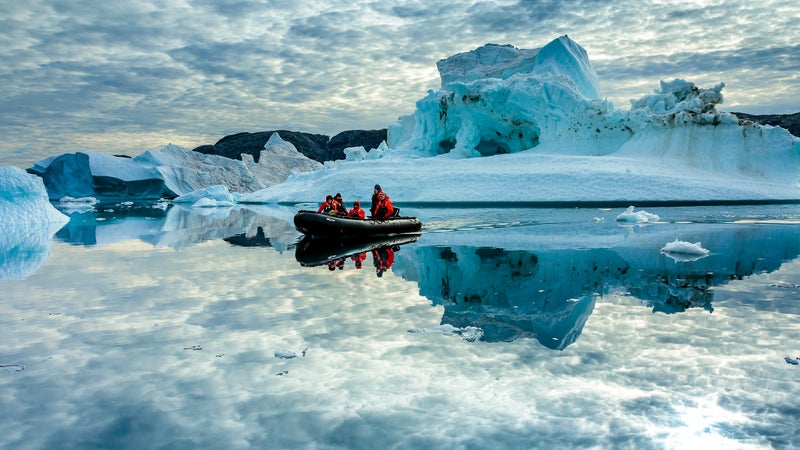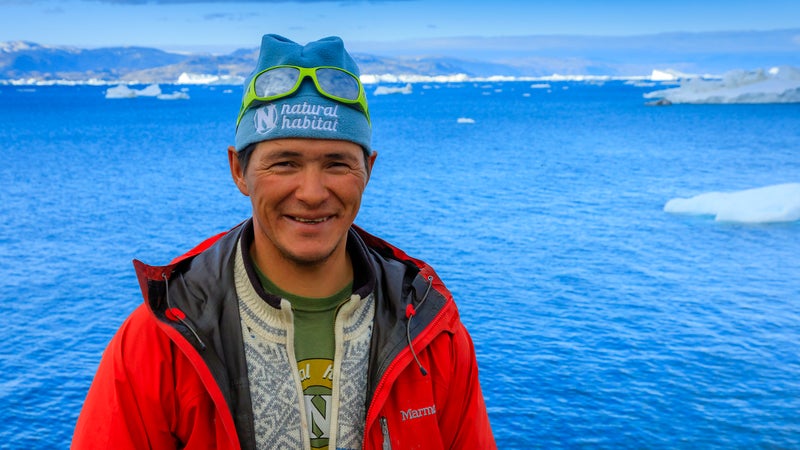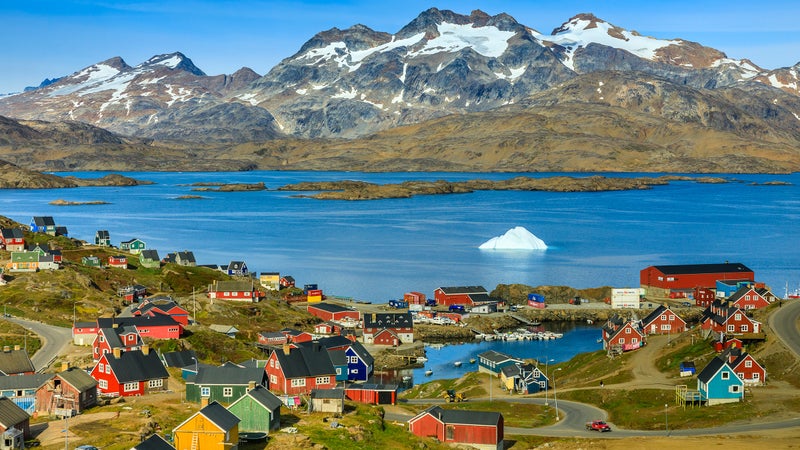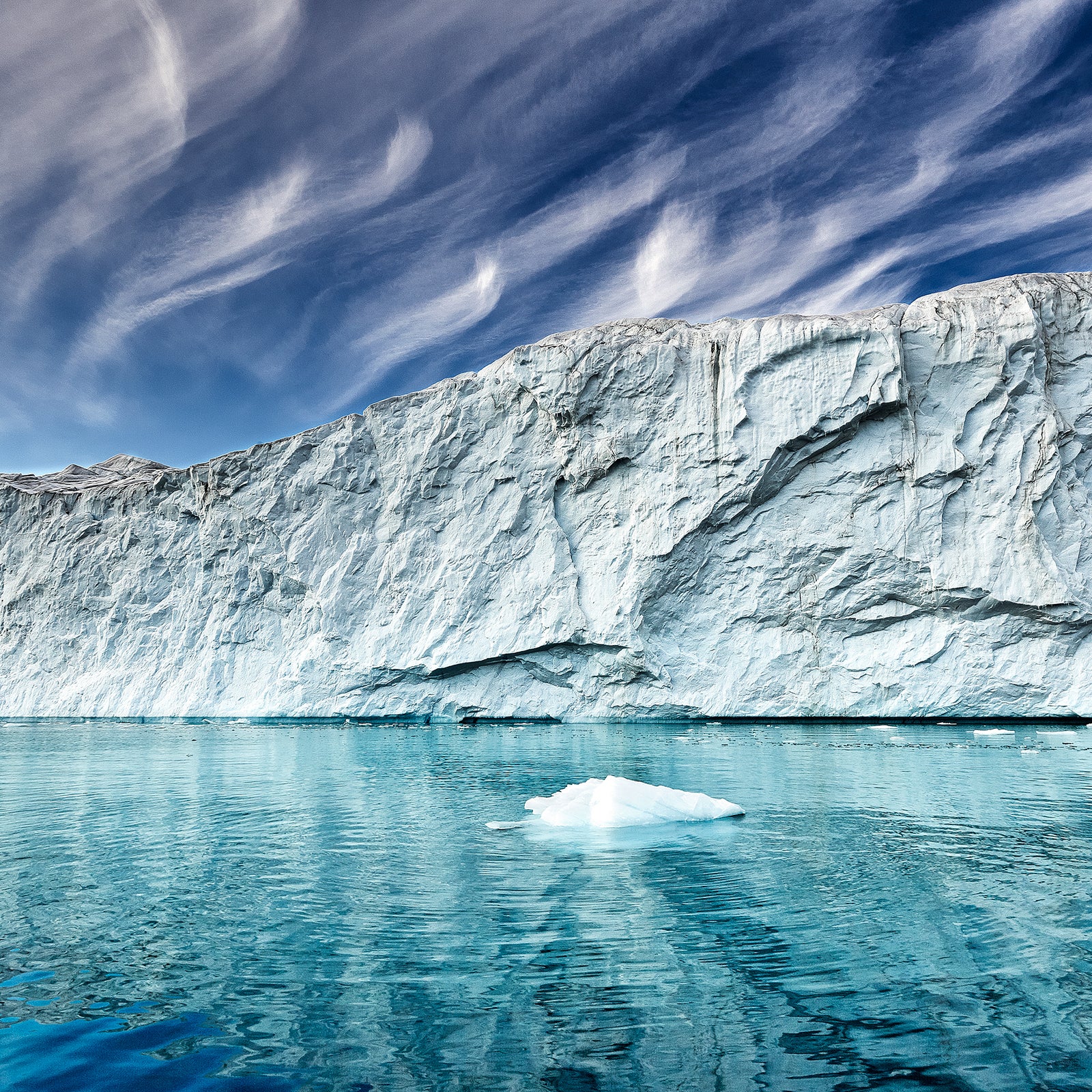Our little rubber Zodiac boat╠řwove around icebergs eight stories high and entered a fjord flanked by high mountain basins. Jagged peaks╠řcalled nunataks╠řrose 5,000 feet into the Arctic clouds, forming a skyline to rival any Patagonia silhouette. Our native east Greenland╠řguide, Julius Nielson, cut the motor and pointed to two fleeting spouts of water to our left. A humpback whale breached, her calf surfacing beside her a second later. Drifting beside their rhythmic rising, our small group was awed into silence.
But it was far from quiet on these northern waters. The explosive breath of the two creatures echoed against the intermittent thundering created by restless tidewater glaciers╠řand another sound: the soft crackling of thousand-year-old air bubbles streaming to the surface, released from icebergs broken off from the vast Greenland ice sheet.
I noticed tears falling down my cheeks. This place had staggered me.

I was boating through Sermilik Fjord as part of a trip with , a company that specializes in responsible adventure travel. Once a relatively obscure spot on the globe, Greenland has been making headlines lately for both trivial reasons () and consequential ones. Its╠řice╠řsheet╠řis melting at an alarming rate. But those science-heavy climate-change stories often fail to convey the magnitude of this place. Even as someone who considers myself a conscious environmentalistÔÇöhaving gotten a masterÔÇÖs degree in environmental studies and spent the past decade doing advocacy workÔÇöthis in-person experience made me want to enact more serious change than any article or statistic has inspired.
So when I was sitting in the Reykjavik airport in Iceland on the way home and saw an article from pop╠řup in my feed about how the best thing we can all do to combat climate change is stop traveling, I couldnÔÇÖt help but feel irked. It╠řwas spurred in part by a recent that found that the environmental impact of tourism is responsible for 8╠řpercent of global emissions╠řfrom transport, shopping, and food. (It should be noted that calculate air travel as only 2 to 2.5 percent of global emissions.) The piece was authored╠řby an established travel writer whoÔÇÖs already gotten to see the world, and it was essentially telling people that they should feel guilty for doing the same.╠řFrankly, it pissed me off.
Not only that, but it missed an important point. Travel is what opens our eyes to whatÔÇÖs at riskÔÇöfrom fragile ecosystems and disappearing wildlife to warming oceans and people strugglingÔÇöand inspires╠řus to fight for it. Could seeing a place actually be worth the 8╠řpercent of global emissions? Especially when that number, while not insignificant, seems diminutive next to the for our buildings and homes╠řor the . In fact, mounting studies show that tourism plays a big role in preservation of the natural world.
The research on how travel has a positive effect on conservation is still relatively new, and one of the most compelling ways to measure it quantitatively is through peopleÔÇÖs willingness to pay to see and conserve our environment. ÔÇťDollar value is the best way to turn heads to show that nature is valuable,ÔÇŁ says Court Whelan, director of sustainability for Natural Habitat ║┌┴¤│ď╣¤═°s. A from the World Travel and╠řTourism Council shows that wildlife tourism generates five times more revenue than illegal wildlife poaching worldwide. Thanks to tourism, an elephant is than dead; IndiaÔÇÖs tiger population has increased in major part because a single wild tiger is in tourism; and several experts agree that gorillas are right now because of tourism. Other similar studies abound for pandas, one-horned rhinos, wolves, polar bears, and other species at risk.
ÔÇťThereÔÇÖs no amount of PowerPoints or David Attenborough specials or magazine articles that come even close to having a personal experience with the things weÔÇÖre protecting,ÔÇŁ╠řsays James Sano, vice president of travel, tourism, and conservation for the╠ř, which protects wildlife and vulnerable places and communities.╠řÔÇťPeople can read about Glacier National Park, but that doesnÔÇÖt hold a candle to someone actually going there.ÔÇŁ Those personal experiences, at destinations╠řlike GlacierÔÇöwhose namesakes are melting so fast that ╠řit will have to be renamedÔÇöspur new behaviors toward conservation, and the WWF has the data to prove it. ÔÇťTravelers contribute [money]╠řat significantly higher levels to our conservation work, on the order of 27 times more compared to those who donÔÇÖt travel,ÔÇŁ Sano says about those registered with the companyÔÇÖs membership program.
Not only can travel help enact change on a personal level, but it can initiate change on╠řa federal level, too. Once governments see how many tourism dollars are going into their natural attractions, they often realize the economic viability in preserving them.╠řÔÇťMany countries know that without natural resources and cultural resources, tourism doesnÔÇÖt work,ÔÇŁ says Casey Hanisko, president of the , citing recent efforts in Jordan and Japan.╠řÔÇťIn╠řJordan, the development of the Jordan Trail as a tourism asset focused on adventure travel has╠řensured that the land and communities around it are protected,ÔÇŁ says Hanisko. Meanwhile, in Japan, ÔÇťwhile its cultural appreciation for nature makes it more naturally focused on preservation, with almost 30 percent of its lands protected, its aging population has made the country more focused on adventure-tourism development, to support a need to bring in international visitors to replace their declining domestic-tourism market.ÔÇŁ

In Greenland,╠řout on Sermilik as we followed in the ripples left behind by the whales, Natural HabitatÔÇÖs Nielson told us that this fjord used to freeze solid in winter with sea ice, making a nearly seamless connection between his village of Tiniteqilaaq and the glaciers descending from the ice sheet across the channel. That ice sheet is╠řthe second largest in the world, behind Antarctica, and accounts for the vast majority of the polar ice cap. ItÔÇÖs two miles thick at its center╠řand stretches 1,500 miles north to south, covering 80 percent of Greenland.
But Sermilik no longer freezes in winter, Nielson said. And this past summer, scientists measured unprecedented melt of the ice sheet while watching parts of its center . Most of the icebergs we threaded through broke from the Helheim Glacier, just north, which has been calving from its sister, the Midgard Glacier, that seals off the fjord to the east. Neilson relayed a conversation he had last week with a sailboat captain who has╠řlong given tours to this isolated region and believes that in ten years the Midgard will be gone completely, that heÔÇÖll be able to sail straight through the fjord to the ocean. Nielson thinks itÔÇÖs more like seven years.
As we passed by these ancient pieces of ice devolving into sea, the low clouds muted everything to gray. After my eyes adjusted, I was struck by a kaleidoscope of color, with each layer of ice taking on a different shade. Then the clouds suddenly parted╠řand revealed a bright blue sky that put our surroundings into new focus.
Watching the clouds part, I was struck by a feeling of heartbreaking clarity, similar to that of understanding something fully for the first time. ItÔÇÖs this moment that Sam Ham, a professor of communication psychology at the University of Idaho, identifies as the transformative lynchpin. Ham, who has been studying environmental interpretation in tourism for nearly 20 years,╠řexplains that itÔÇÖs not just the act of travel that will lead to measurable transformation╠řbut the interpretation of the experience.
Ham pioneered this concept when he consulted with adventure-cruise company in 1998 on its small-boat Gal├ípagos Islands program. In 1997, owner Sven Lindblad had a hunch that if the company asked its passengers to donate to local conservation efforts at the same time they were asked to tip the crew at the end of the journey, theyÔÇÖd jump at the chance. Lindblad raised $50,000 that year╠řbut believed the sum╠řcould have been╠řmuch higher. He brought in Ham, who designed a new approach that was all about helping clients interpret Charles Darwin and the animals╠řand connecting passengers to the environment. At no point were travelers asked to give, but donations to the ╠řincreased by a staggering 270 percent the next year.

Upon returning home from our close-up with the impacts of climate change in Greenland, my fellow traveler╠řKim Borovik╠řfound herself imagining the flight path of an aging banana she bought in the tiny Tasiilaq grocery store while there, leading her to a habit of basing her produce purchases off the origin labels in her own supermarket. Another new friend from the trip, Linnet Tse, began conscious attempts to reduce food waste, which of global emissions,╠řby being more strategic with purchases and eating out less. As for me, I dove headfirst into the rabbit hole that is carbon offsetting. IÔÇÖd never offset my travel before, but now I wanted to figure out how to do it for my upcoming flights╠řto Tanzania.
I found numerous companies that will calculate travel emissions and offer projects that travelers can invest in to offset their trips. I decided to use , a Swiss nonprofit thatÔÇÖs certified with strict third-party auditors like CDM, Gold Standard, and Plan Vivo. The website provides options for calculating individual parts of your trip, from a flight to a car ride, as well as╠řtripÔÇÖs entire carbon footprint. Carbon emissions are measured in metric tons, so offsets are measured in equivalent reductions of metric tons, which are priced anywhere from . My flights from Missoula, Montana, to the Kilimanjaro airport via Amsterdam weighed in at 4.7 tons of CO2, which translates to a cost of $135, a shockingly small price to pay and in this case went to helping small farmers with reforestation in Nicaragua.╠ř
The effectiveness of carbon offsetting has seen , which is why itÔÇÖs crucial to choose projects with third-party certifications. But spending my money on programs╠řlike reforestation, renewable energy, and╠řwater-filtration systems for villages in developing countries, so that people donÔÇÖt have to cut wood and burn it to sanitize drinking water, are all worthy add-ons in╠řan effort to be╠řa more conscious traveler in general, whether that means flying less or╠řmore thoughtfully.
Not every travel experience will be transformative or lead to behavior change, and offsetting flights doesnÔÇÖt give╠řus carte blanche to turn up the taps, but the answer is not to stop traveling altogether. In fact, nowadays, there are as many answers as there are innovative solutions. One of my answers is understanding the impact, both bad and good, of the trips we choose to take. When that understanding leads to concrete steps toward╠řinvesting in climate-change solutions, or when our valuing a place or species through tourism is a driving force in conserving it, then yes, travel is worth the carbon footprint.


